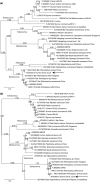2019_nCoV/SARS-CoV-2: rapid classification of betacoronaviruses and identification of Traditional Chinese Medicine as potential origin of zoonotic coronaviruses
- PMID: 32060933
- PMCID: PMC7165814
- DOI: 10.1111/lam.13285
2019_nCoV/SARS-CoV-2: rapid classification of betacoronaviruses and identification of Traditional Chinese Medicine as potential origin of zoonotic coronaviruses
Abstract
The current outbreak of a novel severe acute respiratory syndrome-like coronavirus, 2019_nCoV (now named SARS-CoV-2), illustrated difficulties in identifying a novel coronavirus and its natural host, as the coding sequences of various Betacoronavirus species can be highly diverse. By means of whole-genome sequence comparisons, we demonstrate that the noncoding flanks of the viral genome can be used to correctly separate the recognized four betacoronavirus subspecies. The conservation would be sufficient to define target sequences that could, in theory, classify novel virus species into their subspecies. Only 253 upstream noncoding sequences of Sarbecovirus are sufficient to identify genetic similarities between species of this subgenus. Furthermore, it was investigated which bat species have commercial value in China, and would thus likely be handled for trading purposes. A number of coronavirus genomes have been published that were obtained from such bat species. These bats are used in Traditional Chinese Medicine, and their handling poses a potential risk to cause zoonotic coronavirus epidemics. SIGNIFICANCE AND IMPACT OF THE STUDY: The noncoding upstream and downstream flanks of coronavirus genomes allow for rapid classification of novel Betacoronavirus species and correct identification of genetic relationships. Although bats are the likely natural host of 2019_nCoV, the exact bat species that serves as the natural host of the virus remains as yet unknown. Chinese bat species with commercial value were identified as natural reservoirs of coronaviruses and are used in Traditional Chinese Medicine. Since their trading provides a potential risk for spreading zoonoses, a change in these practices is highly recommended.
Keywords: Sarbecovirus; Traditional Chinese Medicine; bats; coronavirus; epidemic; whole-genome comparison; zoonosis.
© 2020 The Authors. Letters in Applied Microbiology published by John Wiley & Sons Ltd on behalf of Society for Applied Microbiology.
Figures


References
-
- Bermingham,A., Chand,M.A., Brown,C.S., Aarons,E., Tong,C., Langrish,C., Hoschler,K., Brown,K. et al. (2012) Severe respiratory illness caused by a novel coronavirus, in a patient transferred to the United Kingdom from the Middle East, September 2012. Euro Surveill 17, 20290. - PubMed
MeSH terms
LinkOut - more resources
Full Text Sources
Medical
Research Materials
Miscellaneous

